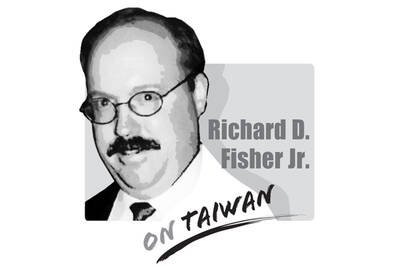The proposal to change the name of Chiang Kai-shek Memorial Hall and the demolition of its outer walls have caused much controversy. The Taipei City Government has attempted to list the memorial hall, which was completed in 1980, as an official historical site. But it has forgotten to preserve the city's historic railways, which were completed more than a century ago in 1893.
As children, we learned from our textbooks such things as the shape of the Republic of China (ROC) is somewhat similar to that of a begonia leaf. Meanwhile, we ignored things that were not covered in the textbooks, such as the 228 Incident. Nor were we taught about the railway construction launched by Taiwan's first governor, Liu Ming-Chuan (劉銘傳), between Keelung and Hsinchu, which came into operation later in 1893. In the book, The 100th Anniversary of Taiwan Railway, there is even a photo of the Keelung Station built by Liu.
But growing up, we realize that the shape of the ROC was more like an old hen, and we began to learn about the massacre that began on Feb. 28, 1947. Moreover, those who study railway history learn that due to the poor quality of Liu's railways, the whole system was abandoned long ago, with only a few historical relics remaining.
In late 2004, during a historical site review, it was determined that the roof of the Taiwan Railway Administration's (TRA) old auditorium might possibly be the frame of the Taipei Station built by Liu. Since relics of the old line are extremely rare, the finding was surely precious. However, faced with pressure to build a new MRT station at the site, it was decided that the auditorium had to be removed during construction of the underground station, then returned to its original location later.
The location of a historical site is of great significance, and they should not be moved arbitrarily. The auditorium built during the Qing dynasty, had withstood Japanese colonization and the post World War II era, as it morphed from a station into a railway workshop and finally an auditorium. It witnessed the rise and fall of the three regimes, and symbolizes the beginnings of Taiwan's industrialization. However, due to the perfunctory decision made by Taipei's Department of Cultural Affairs, it was moved.
Soon after the relocation work started, workers discovered a railway base of the original line about 60cm below the floor. The reappearance of the base was as stunning as that of the "terracotta army" excavated in China, and the scene was magnificent. The problem was, it would be even more difficult to relocate the base. Finally, the department fell in line with the government's call for "desinicization" by removing the Chinese site and demolishing the entire base.
Ever since the historical site was revealed, the department has taken a passive attitude toward it. Despite the cultural value of the site, which contains important historical remains from the Qing dynasty, it has received little attention.
In comparison to the outer walls of the memorial hall, such cherry picking of historical sites is reason for disappointment and resentment.
Ku Ting-wei is a student in the Graduate Institute of Microbiology and Biochemistry at National Taiwan University.
Translated by Eddy Chang
We are used to hearing that whenever something happens, it means Taiwan is about to fall to China. Chinese President Xi Jinping (習近平) cannot change the color of his socks without China experts claiming it means an invasion is imminent. So, it is no surprise that what happened in Venezuela over the weekend triggered the knee-jerk reaction of saying that Taiwan is next. That is not an opinion on whether US President Donald Trump was right to remove Venezuelan President Nicolas Maduro the way he did or if it is good for Venezuela and the world. There are other, more qualified
China’s recent aggressive military posture around Taiwan simply reflects the truth that China is a millennium behind, as Kobe City Councilor Norihiro Uehata has commented. While democratic countries work for peace, prosperity and progress, authoritarian countries such as Russia and China only care about territorial expansion, superpower status and world dominance, while their people suffer. Two millennia ago, the ancient Chinese philosopher Mencius (孟子) would have advised Chinese President Xi Jinping (習近平) that “people are the most important, state is lesser, and the ruler is the least important.” In fact, the reverse order is causing the great depression in China right now,

This should be the year in which the democracies, especially those in East Asia, lose their fear of the Chinese Communist Party’s (CCP) “one China principle” plus its nuclear “Cognitive Warfare” coercion strategies, all designed to achieve hegemony without fighting. For 2025, stoking regional and global fear was a major goal for the CCP and its People’s Liberation Army (PLA), following on Mao Zedong’s (毛澤東) Little Red Book admonition, “We must be ruthless to our enemies; we must overpower and annihilate them.” But on Dec. 17, 2025, the Trump Administration demonstrated direct defiance of CCP terror with its record US$11.1 billion arms
The latest poll released by the Taiwanese Public Opinion Foundation (台灣民意基金會) is not great reading for the Chinese Nationalist Party (KMT) or its chairwoman, Cheng Li-wun (鄭麗文). The poll shows an increase of 7.3 percentage points to 38.4 percent in support for the Democratic Progressive Party (DPP) compared with 20.6 percent for the KMT, down by 5.2 percentage points from the previous poll. Some KMT members say the results have been distorted by the foundation chairman Michael You (游盈隆), whom the DPP administration nominated as chairman of the Central Election Commission on Dec. 22 last year. According to a My